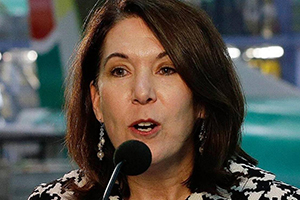Published June 14, 2017 in the Tacoma News Tribune
Boeing Continues to Pare Washington Workforce, Plans to Shift Hundreds of Jobs to Arizona
By Dominic Gates
The Seattle Times
Boeing plans to transfer yet another substantial work group out of the Puget Sound region, the company confirmed Wednesday. The work shifting to Mesa, Ariz., could involve hundreds of jobs.
The changes are coming at Boeing’s Shard Services Group (SSG), which employs about 3,000 people in the Puget Sound region and provides a wide range of support services to Boeing’s corporate and production units.
The unit’s leadership has initiated a sweeping review and has begun to inform specific groups that their work is pegged for moving.
It’s part of Boeing’s intense corporate drive to cut costs, which is largely responsible for the loss of more than 18,300 Boeing jobs in the state since the most recent employment peak in fall 2012.
Boeing aims to complete the SSG reorganization by 2020, but SSG president Beverly Wysewill move from Renton to Mesa sooner.
Wyse, a longtime Boeing exec who previously ran Boeing’s South Carolina complex and headed the Renton 737 assembly plant, said in an interview that the reorganization will also take out some layers of management and is aimed at making SSG more efficient and productive.
Wyse said managers have begun meeting with employees and working out details. At this point, she said, it’s too early to tell how many jobs will be moved.
“In the next six to eight weeks, we’ll understand everyone’s preferences and develop a transition plan for each employee,” Wyse said.
In one affected group, a person with knowledge of the plan said Boeing will offer relocation packages to just 5 to 10 percent of the current employees who are considered critical to the work.
To stay at SSG, the person said, others will have to re-apply for their jobs and accept a lower salary offered in Mesa.
Wyse said the terms of the work transfer will differ from one work group to another.
“We are working through service by service what proportion of each team has critical skills that we have to transfer,” she said.
Job cuts by attrition
SSG, which at the end of May employed almost 5,900 people companywide, provides more than 100 services across Boeing.
Some are specific to each work site, such as security and fire protection, building and equipment maintenance, and real estate management.
Other SSG groups are responsible for broader services across the entire Boeing enterprise, including human resources functions such as pay and benefits; back-office functions such as management of company vehicles, travel expenses and accounts payable; business planning; purchasing non-production equipment and office supplies; and managing the logistics of delivering aerospace parts to Boeing plants across the country.
The groups providing services all across Boeing are the ones tapped for moving to Mesa, Wyse said.
About half of the total SSG employees are currently based in the Puget Sound region, she said.
And because many of their jobs relate to the specific production sites here, “the Puget Sound is our largest footprint and it’ll continue to be our largest footprint” even after the work transfer, she said.
In addition to transferring work to Mesa, the reorganization will reduce jobs through attrition.
With the Puget Sound business economy booming, driven by tech companies like Amazon, attrition in some of her business services groups is as high as 8 to 12 percent per year, she said.
Since Wyse took over as head of SSG in June last year, total employment in the group has already dropped by just over 1,400 people.
Employees rattled
Boeing has transferred work out of Washington state steadily since 2013.
That year, it announced the move of 1,500 IT jobs to St. Louis, Mo., and North Charleston, SC.; nearly 700 commercial airplane engineering support jobs to southern California; and 1,000 research engineering jobs to Huntsville, Ala.; St. Louis and North Charleston, S.C.
In 2014, it announced the transfer of 1,000 more commercial airplane engineering support jobs to southern California and then 2,000 defense-side jobs to to Oklahoma City, Okla., and St. Louis.
Most of the employees affected by those earlier work transfers were members of the white-collar Society of Professional Engineering Employees in Aerospace (SPEEA) union.
In contrast, most SSG employees are non-union. About 140 SPEEA members work in facilities for SSG and will not be affected by the work transfer, Boeing said.
Wyse said she’s striving to make the process of moving work to Mesa a humane and deliberate one that gives “the people who have gotten us to where we are today the opportunity … to make a respectful transition.”
She said she is hoping for “minimal, if any, involuntary layoffs” as some employees leave for other companies and others find positions in Boeing’s other operations here.
She said SSG employees working in finance, planning or supplier management can look for jobs within the Commercial Airplanes unit that demand similar skills.
“We’ll give this a long tail,” Wyse said. “People deserve the opportunity to find a good transition.”
However, employees are understandably rattled.
One young SSG analyst said an all-hands meeting last week raised fears of job losses without providing any reassurance about the chances of still having a future at Boeing.
“We didn’t get good answers,” the analyst said.
He said he understands that Boeing needs to be more competitive and cut costs. He said SSG has many inefficiencies, such as multiple databases that don’t interact so that it’s difficult to track total spending.
Still, he said, the company needs to be less “heartless” in making decisions that profoundly affect employees and their families.
He’s now actively looking for another job.
“Boeing will do what it needs to do to survive,” the analyst said. “So will I.”
http://www.thenewstribune.com/news/business/article156257599.html
